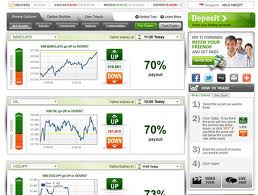History of Binary Options
 The history of binary options can be traced to 2008 when it was first introduced publicly as a tradable asset on the Chicago Board of Exchange (CBOE). 2008 was a year that will not be forgotten in human history. That was the year that the cards came crashing in the financial markets, as the subprime mortgage crisis in the US triggered the collapse of Bear Stearns and Lehman Brothers, and subsequently the global financial system. With such a situation that cost many everyday investors all over the world a lot of money, there was a lot of pressure for investments with a lower risk profile to be made available to traders. This was what led to the entrance of binary options trading as a new form of investment for the average trader.
The history of binary options can be traced to 2008 when it was first introduced publicly as a tradable asset on the Chicago Board of Exchange (CBOE). 2008 was a year that will not be forgotten in human history. That was the year that the cards came crashing in the financial markets, as the subprime mortgage crisis in the US triggered the collapse of Bear Stearns and Lehman Brothers, and subsequently the global financial system. With such a situation that cost many everyday investors all over the world a lot of money, there was a lot of pressure for investments with a lower risk profile to be made available to traders. This was what led to the entrance of binary options trading as a new form of investment for the average trader.
Even though binary options gained mainstream popularity in 2008, it has actually been around for quite some time. In years gone by, binary options were a semi-official investment product, open only to banks, other institutional and high net-worth investors in the Over-the-Counter (OTC) markets. In essence, the situation with binary options was not much different from what obtained with forex trading prior to 1997 when that market was deregulated.
In order to understand when the practice of trading binary options actually started, we would have to go back almost 40 years, to 1973 when options trading on financial instruments commenced on the newly created CBOE. These early days were difficult as the regulatory framework for trading options were not yet developed. Over the years, binary options trading evolved as a less complicated way of trading options. They were still offered as part of larger and more complex contracts, and as mentioned earlier, there was no regulation whatsoever for binary options. There was still no separate liquid market for trading binary options.
These conditions existed until 2007. By this time, the subprime mortgage crisis had begun to play out with the collapse of real estate prices. The Options Clearing Committee (OCC), which had been created in the early 70s to develop the regulatory framework for the options markets, proposed changes that would see binary options elevated to the status of a financial asset that could be traded on its own in the major exchanges. By early 2008, the US Securities and Exchange Commission (SEC) accepted the recommendations of the OCC and made it legal for binary options to be offered on major exchanges as a stand-alone, tradable financial instrument. By May of the same year, the American Stock Exchange (AMEX) started offering binary options to the public for the first time, and the CBOE followed suit the following month.
Even as at 2008, the process by which binary options were traded on the CBOE and AMEX were cumbersome and restrictive. Traders who wanted to buy binary options on CBOE had to purchase the contracts on the S&P 500 index, and only one type of options (call options) could be purchased.
The advances in information technology which has seen the advent of trading software that have been deployed for online use as well as mobile versions of the trading platforms, have seen an explosion of binary options trading. There is a lot more flexibility now. No longer are traders restricted in terms of where to trade or the type of options to trade. Traders can now trade both call and put binary option types, trade a plethora of financial assets across several markets, and can now trade binary options on the go with their smartphones.
In addition, many more trade varieties have evolved, with traders now being able to trade binary options in three different ways. Recently, a few brokers such as Optionfair.com have upped the ante by being pioneers in providing simulated trading and charting tools for traders to conduct technical analysis prior to trades. This is something that had been traditionally absent with binary options trading.
With more brokers and vendors coming up with products for the binary options markets, the true beneficiaries are none other than the traders, who now have better options when it comes to binary options trading. With the blazing speed at which technological innovations have come on stream in the last 5 years beginning with the iPhone, one can only imagine what the future would hold. One thing is sure; if this blog were to rewrite this article in the next 5 years, there would be a lot more to say about the history of binary options trading.